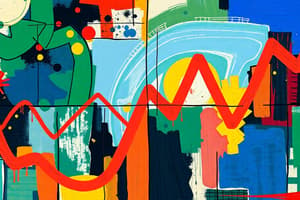Podcast
Questions and Answers
What is the primary focus of fiscal policy?
What is the primary focus of fiscal policy?
- Implementing trade policies
- Manipulating interest rates
- Influencing the economy through spending and taxation (correct)
- Controlling money supply
Which of the following is NOT a typical role of a Research Assistant in macroeconomics?
Which of the following is NOT a typical role of a Research Assistant in macroeconomics?
- Policy-oriented tasks
- Analysis support
- Writing academic papers independently (correct)
- Data collection
What does Gross National Debt include?
What does Gross National Debt include?
- Both domestic and foreign debt (correct)
- Foreign debt only
- Private debt
- Only domestic debt
In academia, how long does a Research Assistant typically work under a professor before pursuing a PhD?
In academia, how long does a Research Assistant typically work under a professor before pursuing a PhD?
What are structural policies primarily aimed at?
What are structural policies primarily aimed at?
Which branch of economics focuses on analyzing the behavior and performance of an entire economy?
Which branch of economics focuses on analyzing the behavior and performance of an entire economy?
What is the primary emphasis of macroeconomics?
What is the primary emphasis of macroeconomics?
Which approach in macroeconomics quantifies economic patterns using statistical methods?
Which approach in macroeconomics quantifies economic patterns using statistical methods?
What does the Unemployment Rate measure?
What does the Unemployment Rate measure?
Which indicator measures the total monetary value of all goods and services produced in an economy?
Which indicator measures the total monetary value of all goods and services produced in an economy?
Flashcards are hidden until you start studying
Study Notes
Macroeconomics: Understanding the Big Picture
Macroeconomics is a branch of economics that focuses on understanding and analyzing the behavior and performance of an entire economy, rather than individual markets or firms. This field explores broad trends, patterns, and relationships within an economy, with a particular emphasis on topics like economic growth, inflation, unemployment, and fiscal and monetary policies.
Macroeconomic Approaches
Macroeconomists utilize two primary approaches to study the economy:
- Descriptive Economics: This approach seeks to quantify and explain economic patterns and relationships using statistical methods and data analysis.
- Theoretical Economics: This approach aims to develop and test economic theories that can help predict and explain economic behavior and outcomes.
Macroeconomic Indicators
Macroeconomists use a variety of indicators to measure and analyze economic conditions. Some of the most commonly used indicators include:
- Gross Domestic Product (GDP): A measure of the total monetary value of all goods and services produced in an economy.
- Unemployment Rate: A measure of the percentage of the labor force that is without employment.
- Inflation Rate: A measure of the rate at which the general level of prices for goods and services is rising.
- Interest Rates: A measure of the cost of borrowing money, which impacts business investment and consumer spending.
- Gross National Debt: A measure of a country's total debt, which includes both domestic and foreign debt.
Macroeconomic Policies
Macroeconomic policies are tools used by governments and central banks to influence the economy in an effort to achieve specific goals such as:
- Fiscal policy: A government's use of spending and taxation to influence the economy.
- Monetary policy: A central bank's use of interest rates, reserve requirements, and money supply to influence the economy.
- Structural policies: Government policies that aim to improve the efficiency and competitiveness of the economy, such as trade policies, labor market policies, and education policies.
Research Assistants in Macroeconomics
Research Assistants (RAs) play a vital role in supporting macroeconomic researchers, often helping with data collection, analysis, and writing. In academia, an RA typically works under a professor for 1-3 years before pursuing a PhD. In policy organizations like think tanks, multilaterals, and government agencies, the role is broader and can include policy-oriented tasks.
Conclusion
Macroeconomics is a dynamic and interdisciplinary field that offers unique insights into the behavior and performance of the global economy. With an emphasis on broad trends, patterns, and relationships, this field is crucial in helping policymakers and economists make informed decisions that can lead to sustainable economic growth and stability.
Studying That Suits You
Use AI to generate personalized quizzes and flashcards to suit your learning preferences.




